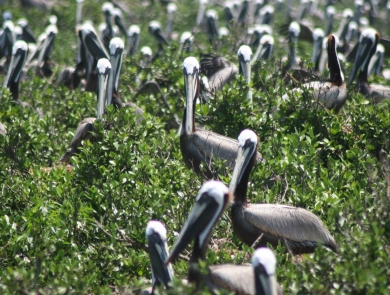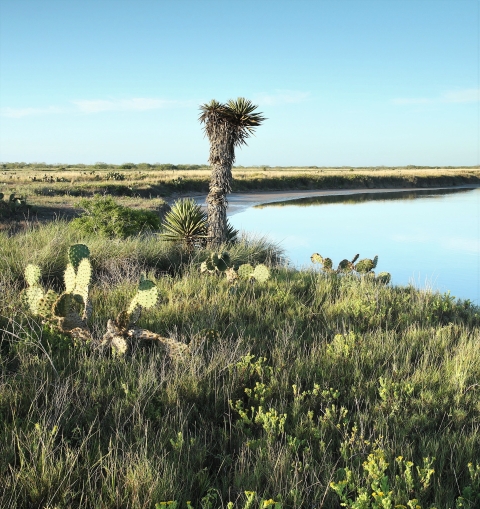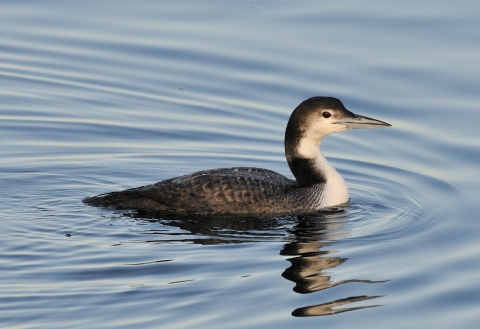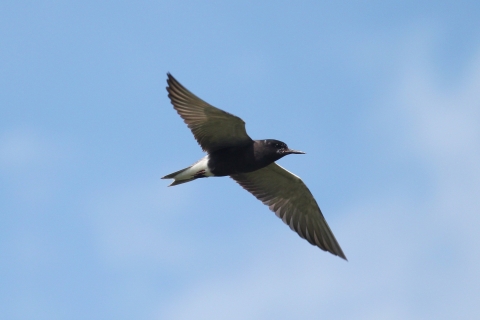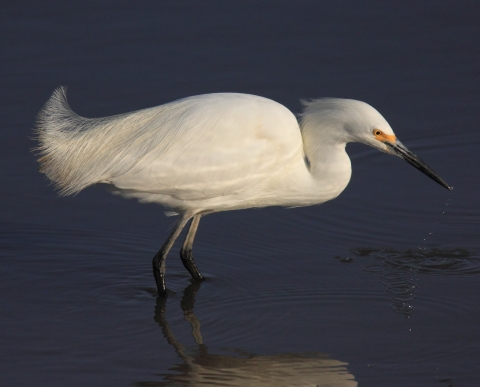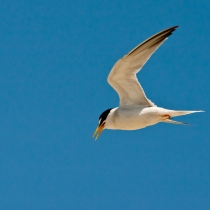What We Do
Our Services
We work collaboratively across the Gulf of America region to restore the natural resources that were injured by the Deepwater Horizon oil spill.
When the oil spill occurred in 2010, the Service deployed staff from across the country to help with the response. Soon thereafter, we joined in the comprehensive and largest ever post-oil spill assessment of the natural resource injury caused by both the oil and response and clean-up activities. We managed the parts of the assessment that looked at the impacts on by birds, the Gulf sturgeon, and our national wildlife refuges and national parks.
Now, with the injury assessment complete and the historically large 2016 global settlement with BP reached, we are focusing all of our energy on developing and implementing restoration projects that will restore the Gulf of America to the condition it would be in but for the spill.
Our Projects and Initiatives
The Service's mission - to conserve, protect and enhance fish, wildlife, plants and their habitats for the continuing benefit of the American people - is at the heart of all of our work, including our work in the Gulf of America region. To do this, we collaborate with many partners, including the five states bordering the Gulf, other federal agencies, non-governmental groups, and the public. We have specific responsibility to help restore federally-managed lands. We also assist with the recovery of a number of federally listed endangered, threatened, and at risk species. Additionally, the Migratory Bird Treaty Act makes the Service responsible for the protection of migratory birds and many of our Gulf projects benefit these species.
We are working primarily with three entities that are receiving an unprecedented level of funding to restore injured natural resources and the services they provide, such as recreation. The Resources and Ecosystems Sustainability, Tourist Opportunities, and Revived Economies of the Gulf Coast States Act (RESTORE) Council as well as the Deepwater Horizon Natural Resource Damage Assessment Trustees (DWH NRDA Trustees) are funded by a 2016 settlement reached with BP, the party deemed primarily for the spill. We are also advisors to, and at times implement projects for, the National Fish and Wildlife Foundation’s Gulf Environmental Benefit Fund (NFWF GEBF).
Our Library
Projects and Research
We have restoration projects across the Gulf region. Here is a partial list of the those projects:
Bon Secour National Wildlife Refuge Trail Enhancement Project (NRDA funded)
This project repaired and enhanced the Jeff Friend Trail. The boardwalk and gravel trail was repaired and improved to meet American Disability Act standards, to ensure safe public access, and to enhance the quality of visitor experience. An observation platform was constructed along the trail.
Laguna Atascosa Habitat Acquisition (NRDA funded)
Together with our Texas Trustees, we have acquired approximately 1,300 acres of tidal wetlands, thorn scrub, and coastal prairie. The Service is now managing the land as part of the Laguna Atascosa National Wildlife Refuge.
Little Lagoon Living Shoreline (NRDA funded)
Shoreline techniques were used to restore 2,200 feet of heavily eroded area along the southwestern corner and southern shore of Little Lagoon in the Bon Secour National Wildlife Refuge in coastal Alabama. A combination of biodegradable coconut fiber logs, plantings (Spartina alterniflora and Juncus roemerianus), and wave attenuation structures were used to stabilize the shore. Stabilization of the shoreline is reducing erosion of adjacent habitat supporting endangered Alabama beach mouse and help creating more storm-resilient and biologically productive shoreline habitats.
Louisiana Outer Coast Restoration (NRDA funded)
This project restores beach, dune, and back-barrier marsh habitats, as well as brown pelicans, terns, skimmers, and gulls at four barrier island locations in Louisiana: Chenier Ronquille, Shell Island, North Breton Island, and Caillou Lake Headlands (also known as Whiskey Island). The State of Louisiana, NOAA, and DOI are working cooperatively on this project.
McFaddin Beach and Dune Restoration (NRDA funded)
This project includes placement of sand along an 18-mile section of shoreline along the northeastern Texas coast and provides important benefits to the interior marshes of McFaddin National Wildlife Refuge. This project funds about a third of the estimated $45 million total project cost. The Texas TIG will partner with other funding sources to complete the construction, monitoring, and/or planning activities. The Department of the Interior and Texas are working together to implement this project.
Mid-Coast Habitat Acquisition (NRDA funded)
This project acquires approximately 800 acres of habitat that provide a protective buffer to estuarine and bay waters from future land use changes. The land will be conveyed to the U.S. Fish and Wildlife Service to be managed as part of the Texas Mid-Coast National Wildlife Refuge Complex in Matagorda County, Texas. The Department of the Interior and Texas are working together to implement this project.
Restoration of Common Loons in Minnesota (NRDA funded)
This project takes advantage of a robust common loon conservation ethic and history of financial and citizen-based support in the upper Midwest. Currently, there are many ongoing loon conservation efforts in Minnesota. The Open Ocean TIG's goal is to collaborate closely with and support those existing efforts where practicable. The project goals are to reduce mortality and increase reproductive success of common loons at breeding and nesting locations in Minnesota. Common loons represent one of the top five bird species injured in the greatest numbers by the DWH incident.
Restoration of Black Terns in North and South Dakota (NRDA funded)
This project will protect and conserve palustrine, emergent wetland and adjacent upland grassland habitats in the Prairie Pothole Region to enhance and improve breeding site selection and foraging for black terns in roughly 30 counties in eastern North and South Dakota. Conservation easement agreements will be implemented on a voluntary basis with participating landowners as part of ongoing U.S. Fish and Wildlife Service conservation programs in these states. All habitat conservation actions will be implemented, as part of ongoing FWS conservation programs in the Dakotas. In these, two states alone, there are over 1,200 private landowners on waiting lists to have their property evaluated for additional FWS wetland and grassland conservation easements.
Texas Rookery Islands (NRDA funded)
This project will restore and protect three rookery islands in Galveston Bay and one in East Matagorda Bay to increase nesting pairs of colonial waterbirds, such as pelicans, gulls, and herons by increasing the amount of available nesting habitat and enhance habitat quality. Islands will be protected by expanding island size, establishing vegetation, and building protective features such as breakwaters. The Department of the Interior and Texas are working together to implement this project.
Improving Habitat Injured by Spill Response: Restoring the Night Sky (NRDA funded)
This project will retrofit existing lighting to make it more turtle friendly at locations in Florida and Alabama. The Department of the Interior is working with Alabama and Florida state agencies to implement this project. .
Louisiana Outer Coast Restoration (NRDA funded)
This project restores beach, dune, and back-barrier marsh habitats, as well as brown pelicans, terns, skimmers, and gulls at four barrier island locations in Louisiana: Chenier Ronquille, Shell Island, North Breton Island, and Caillou Lake Headlands (also known as Whiskey Island). The State of Louisiana, NOAA, and DOI are working cooperatively on this project.
Texas Rookery Islands (NRDA funded)
This project will restore and protect three rookery islands in Galveston Bay and one in East Matagorda Bay to increase nesting pairs of colonial waterbirds, such as pelicans, gulls, and herons by increasing the amount of available nesting habitat and enhance habitat quality. Islands will be protected by expanding island size, establishing vegetation, and building protective features such as breakwaters. The Department of the Interior and Texas are working together to implement this project.
Tribal Youth Conservation Camps (a Component of Gulf of Mexico Habitat Restoration via Conservation Corps Partnerships) (RESTORE funded)
This project will establish a workforce-training program for local workers (particularly youth, veterans and displaced workers) that will provide paid, hands-on work experience in on-the-ground restoration projects selected for funding and implementation under Deepwater Horizon-related recovery programs.
Grand Bay Land Acquisition and Habitat Management (NRDA funded)
This project includes acquisition of up to 8,000 acres and managing up to 17,500 acres of land within the boundaries of the Grand Bay National Wildlife Refuge, Grand Bay National Estuarine Research Reserve, and Grand Bay Savanna Coastal Preserve in Jackson County, Mississippi. We are using invasive species invasive species
An invasive species is any plant or animal that has spread or been introduced into a new area where they are, or could, cause harm to the environment, economy, or human, animal, or plant health. Their unwelcome presence can destroy ecosystems and cost millions of dollars.
Learn more about invasive species management and prescribed fire to protect important contiguous lands and waters and restoring and managing wildlife habitats.The Department of the Interior and Mississippi are working together to implement this project.
Our Species
The Service is dedicated to ensuring the protection and management not only of our federal trust resources (migratory birds, interjurisdictional fisheries, federally threatened and endangered species and public lands), but also of at-risk species and those of concern to our partners. Protecting these species means we also must conserve and protect their habitats.
The Gulf Region is home to an enormous number and variety of wildlife species. The Gulf Coast is home to 132 federally listed species, 95 of which are endangered. The Migratory Bird Treaty Act makes the Service responsible for the protection of migratory birds and many of our Gulf projects benefit these species. The Service’s Gulf Restoration Office leads our Deepwater Horizon Gulf of Mexico restoration efforts. Much of our work benefits America’s national wildlife refuges; we have 45 refuges along the Gulf of Mexico. We also assist with the recovery of a number of federally threatened, endangered, and at risk species.






